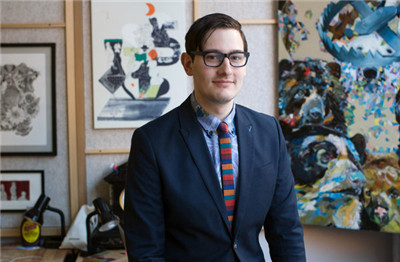(单词翻译:单击)
If museums face an uncertain future, you wouldn’t know it from “Henri Matisse: The Cutouts,” which recently drew 664,000 to the Museum of Modern Art. The show was so thronged that MoMA kept its doors open round-the-clock on the closing weekend last month.
虽然博物馆的未来充满不确定,但最近足足吸引了66.4万名观众的“亨利·马蒂斯:剪纸艺术展(Henri Matisse: The Cutouts)”绝然看不出博物馆的萧条。由于这场在纽约现代艺术博物馆(MoMA)举办的展览太过火爆,馆方不得不在上个月最后一个周末通宵开放展馆。

But blockbusters like Matisse may be deceptive. Art museum attendance dipped 5 percent from 2002 to 2012, according to the National Endowment for the Arts. Museumgoers 75 and older were the only age group to increase over that period. The guardians of posterity must be concerned about the future, no matter how long the lines may be.
但像马蒂斯这样轰动的展览毕竟是个例。据美国国家艺术基金会(the National Endowment for the Arts),美术馆的参观人数在2002年至2012年十年间下降了5%,期间,去博物馆的人中只有75岁及以上年龄段的人数有所上升。但不管参观的队伍排多长,子孙后代的监护者都得思考博物馆的未来该怎么办。
Curators worry most about millennials. How do static galleries of canvas and artifact engage a generation raised on the reactive pleasures of right swipes and hyperlinks? How do you sell Goya when “Game of Thrones” is a click away?
馆长们最最担心的,就是千禧一代。怎样才能让从小就体验着向右滑动屏幕和超链接这类互动乐趣的一代人,对安静的画廊和艺廊感兴趣呢?怎样才能在点点鼠标就能看《权力的游戏》(Game of Thrones)”的时代里,吸引大家去看艺术家戈雅(Goya)的作品呢?
Internet technology presents diversions, but may also offer new ways of engaging younger visitors in art, science and history. This year many museums will install a new form of Bluetooth technology known as beacons. Patrons who download a smartphone app can be tracked within a few feet as they wander the galleries. The beacons can detect whether they’re standing at a Warhol print or a Cartier-Bresson photograph and, like a digital docent, can beam them a rich feed of information about those works, including audio talks, videos and reviews.
网络科技带来各种消遣方式的同时,或许也能提供吸引年轻游客关注艺术、科学和历史的新思路。很多博物馆都计划在今年安装一种新型蓝牙产品——信标(beacons)。参观者下载智能手机应用后,可以在展馆中离信标几英尺的范围内被追踪到。信标能检测出参观者是站在沃霍尔(Warhol)的画作前,还是卡蒂尔-布雷松(Cartier-Bresson)的摄影作品前,然后像数码讲解员一样,输出一系列与作品相关的信息,包括音频、视频讲解和评论等。
“The beacons amplify the experience,” said Brendan Ciecko, founder of Cuseum, a Boston start-up that is testing beacons in the Neue Galerie in New York and the List Visual Arts Center at M.I.T., among other museums. “Tech can, and should, bring joy and enrichment to galleries.”
“信标能提升用户体验,”波士顿Cuseuem的创始人布伦达·扎艾克(Brendan Ciecko)说;Cuseum这家创业公司目前正在纽约新美术馆(Neue Galerie)和麻省理工学院List视觉艺术中心等地方测试信标技术。“科技可以、也理应为美术馆增添趣味,丰富体验。”
You can text or email the museum’s images to a friend, or post them on Facebook or Twitter. And visitors can navigate to works in far-flung galleries as they would with Google Maps — no small convenience in the labyrinthine halls of the Metropolitan Museum of Art.
参观者可以把博物馆的图片彩信或邮件发给朋友或者发布到Facebook和Twitter账户上,还可以用谷歌地图导航,去往距离较远的展厅看展品——这对于展厅如迷宫般复杂的大都会艺术博物馆(Metropolitan Museum of Art)来说,可谓方便不少呢。
The technology “provides visitors with an effortless, rich mechanism that allows them to opt in or opt out for as much as they want to know,” said Elizabeth E. Barker, director of the Boston Athenaeum, which will begin using beacons in time for a show on the Marquis de Lafayette in June. Graphic panels can now be moved online, she added, affording a less cluttered encounter between patron and art.
这项技术“通过一种简单有趣的方法,让游客能自主选择他们想了解的内容”,波士顿图书馆(Boston Athenaeum)馆长伊丽莎白·E·巴尔克(Elizabeth E. Barker)说,图书馆决定在今年6月关于吉尔贝尔·杜·莫提耶(Marquis de Lafayette)的展览上开始使用信标技术。她补充说道,图解面板现在可以移至线上,这就减少了游客和艺术品之间乱七八糟的东西。
More important, beacons allow for an alternative to the old convention of top-down exhibitions, in which curators and other experts impart a single authoritative view. Visitors may now post a lively mix of reactions, reviews and rebuttals to exhibitions and individual works, just as readers do in online newspaper comment fields and restaurantgoers do on Yelp.
更重要的是,信标技术提供了一种有别于传统的自上而下专制式展览的新方式;在以前在展览中,参观者只能看到馆方或其他专家的一面之词,现在,他们可以把对展览和艺术品的反应、评论、不满贴出来,就像读者在网络报纸的评论区、去过某个餐馆的人在Yelp上做的一样。
The result is a cross between curating and crowdsourcing, a two-way conversation. “You shouldn’t have to be a professional curator to have a voice that matters,” said Robert Stein, deputy director of the Dallas Museum of Art, which has experimented with a variety of location-aware technologies but is not currently using beacons.
这是策展和众包(crowdsourcing)相互融合、互相流通的结果。“不是说非得是专业的策展人才能发表意见,”达拉斯艺术博物馆(Dallas Museum of Art)的副馆长罗伯特·斯坦因(Robert Stein)说道,他进行了一系列定位科技的实验,但目前还未使用信标技术。
Elizabeth Merritt, founding director of the Center for the Future of Museums, an arm of the American Alliance of Museums, pointed out that remarks written in virtual comment fields could relate shows to current issues in a way that curators usually cannot.
美国博物馆协会(American Alliance of Museums)成员、未来博物馆中心(the Center for the Future of Museums)创始馆长伊丽莎白·梅里特(Elizabeth Merritt)指出虚拟平台上的评论可以把展览和当下的现实问题联系在一起,这是策展人往往做不到的。
“The time required to compose and print graphic labels makes it impossible to be of-the-moment,” she said, adding that an exhibition on race riots might prompt visitors to relate them to the recent unrest in Ferguson, Mo. “Now you have the historical echo,” Ms. Merritt said.
“撰写和制作图标是需要时间的,这导致这些图标往往缺乏及时性,”她说道。她又补充举例,说一个关于种族骚乱的展览可能让游客联想到最近密苏里州弗格森市的骚乱。“这样,历史的共鸣就出现了,”梅里特女士说。
Apple and other companies started beacon technology two years ago with retail use in mind, but cultural institutions have latched onto the possibilities. Most major museums, including the Guggenheim and the Met, are in various stages of testing and installation — no small job. Coverage requires hundreds of puck-size transmitters. For the Boston Athenaeum, the cost is the equivalent of “throwing one gala fund-raiser,” Dr. Barker said.
两年前,苹果和其他公司就针对零售业开始推出信标技术,但如今文化机构也抓住了机遇。大多数主流博物馆,包括古根海姆(Guggenheim)和大都会博物馆(Met),都纷纷进入了测试安装的不同阶段——工程量都不小。覆盖工程需要数百台冰球大小的发射机。对于波士顿图书馆,这一工程的费用用巴克博士的话说“举办一场筹款晚会”就够了。
Inevitably, some museums, the Frick Collection in New York and the Isabella Stewart Gardner Museum in Boston among them, will choose to maintain galleries as places of quiet contemplation undisturbed by the jangle of phone alerts. “We all want to preserve the gallery as an escape,” Mr. Stein said. “We have to make beacons part of an elegant experience. If we fail, then the public gets annoyed.”
当然,某些博物馆,如纽约弗里克收藏馆(Frick Collection)和波士顿的伊莎贝拉嘉纳艺术博物馆(Isabella Stewart Gardner Museum),选择保留美术馆帮助人们逃离刺耳的手机铃声和陷入安静沉思的作用。“我们都希望美术馆能继续像世外桃源一样,”斯坦因先生说。“为此我们不得不让信标技术完全融入过去的典雅体验,一旦融合得稍有偏差,游客就会感到烦心。”
The benefits of audience data may be too great to resist. For one thing, beacons allow museums to send personalized messages based on visitors’ past behavior.
受众信息的诱惑大概实在太难抵御,而且,信标让博物馆可以依据参观者过去的游览记录来推送个性化信息。
Nobody knows if the guests’ collective likes and dislikes will influence curatorial decisions. “Does a museum deliver what the market appears to ask for?” asked Susie Wilkening, who, as senior consultant at Reach Advisors, specializes in audience research for museums. “Do they ignore areas that don’t test well?”
没人知道顾客的集体喜恶能否影响策展决定。“博物馆应该提供市场所需求的吗?”Reach Advisors公司专注于博物馆受众研究的高级顾问苏茜·威尔肯宁(Susie Wilkening)问道。“他们会忽视那些效果不好的地方吗?”
Add to these hypotheticals the possibility of exchanging data with a company like Google, which would afford museums a depth of knowledge about patrons’ preferences. “These are the issues museums are now discussing,” Ms. Wilkening said.
除了以上假设下的问题外,博物馆还有可能与谷歌这样的公司交换数据,以更深入了解顾客的喜好。“这些都是博物馆正在讨论的问题,”威尔肯宁女士说。
As with many aspects of modern life, patrons who opt for beacon apps willingly trade a measure of privacy for the benefit of a more personalized interaction with art.
与现代生活的很多其他方面相似,选择使用包含信标技术应用的客户们愿意牺牲适度的隐私来换取与艺术作品之间更个性化的交互体验。
“My sense is that beacons aren’t a life raft,” Dr. Barker said, “but a bridge to the next generation of museum users.”
“我觉得信标技术不是博物馆的救生筏,”巴克博士说,“只是一座连接下一代博物馆参观者的桥梁而已。”


